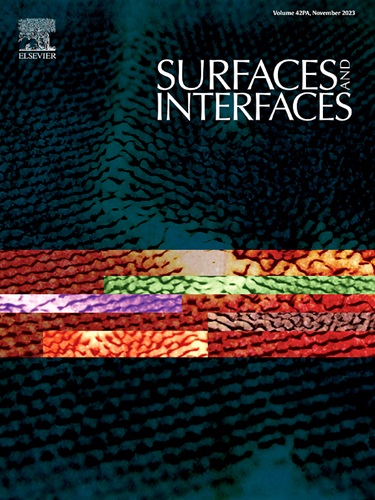通过构建CdWO4/Mn0.5Cd0.5S界面异质结增强光催化析氢
IF 6.3
2区 材料科学
Q2 CHEMISTRY, PHYSICAL
引用次数: 0
摘要
MnxCd1-xS是一种新兴的半导体光催化剂,具有可调的带隙和高的可见光响应。然而,电荷复合速率高和光腐蚀严重是制约其进一步应用的两个主要缺陷。本文采用水热法制备了CdWO4/Mn0.5Cd0.5S界面异质结。CdWO4纳米棒和Mn0.5Cd0.5S纳米多面体的均匀分布保证了较大的接触面积,有利于在界面处形成更多的异质结。通过调整CdWO4的负载量,优化后的9CdWO4/Mn0.5Cd0.5S二元复合材料的氢析出率达到8417.1 μmol·g-1·h-1,优于Mn0.5Cd0.5S单体和CdWO4单体。该复合材料在420 nm处表现出良好的稳定性,表观量子产率(AQY)为14.13%。通过各种表征分析了材料的载体转移和光催化制氢机理。这项工作为cdwo4基宽带隙半导体在光催化制氢中的应用提供了有价值的思路。本文章由计算机程序翻译,如有差异,请以英文原文为准。

Enhanced photocatalytic hydrogen evolution through the construction of CdWO4/Mn0.5Cd0.5S interfacial heterojunction
MnxCd1-xS is an emerging semiconductor photocatalyst due to the tunable band gap and high visible light response. Nevertheless, high charge recombination rate and severe photo-corrosion are two main drawbacks inhibit its further application. In this paper, CdWO4/Mn0.5Cd0.5S interfacial heterojunctions were formed by the hydrothermal process. The homogeneous distribution of CdWO4 nanorods and Mn0.5Cd0.5S nanopolyhedra ensure large contact areas, facilitating more heterojunctions formed at the interfaces. By adjusting the CdWO4 loading, the optimized binary composite, 9CdWO4/Mn0.5Cd0.5S, reached the hydrogen precipitation rate of 8417.1 μmol‧g-1‧h-1, surpassing both Mn0.5Cd0.5S and CdWO4 monomer. The composite also showed brilliant stability, and an Apparent Quantum Yield (AQY) of 14.13 % at 420 nm. The carrier transfer and photocatalytic hydrogen production mechanisms of the materials were analyzed through various characterizations. This work offered valuable ideas for the application of CdWO4-based wide-bandgap semiconductors towards photocatalytic hydrogen production.
求助全文
通过发布文献求助,成功后即可免费获取论文全文。
去求助
来源期刊

Surfaces and Interfaces
Chemistry-General Chemistry
CiteScore
8.50
自引率
6.50%
发文量
753
审稿时长
35 days
期刊介绍:
The aim of the journal is to provide a respectful outlet for ''sound science'' papers in all research areas on surfaces and interfaces. We define sound science papers as papers that describe new and well-executed research, but that do not necessarily provide brand new insights or are merely a description of research results.
Surfaces and Interfaces publishes research papers in all fields of surface science which may not always find the right home on first submission to our Elsevier sister journals (Applied Surface, Surface and Coatings Technology, Thin Solid Films)
 求助内容:
求助内容: 应助结果提醒方式:
应助结果提醒方式:


